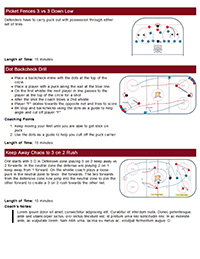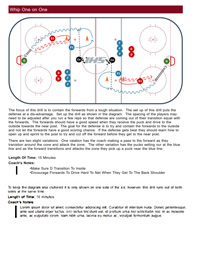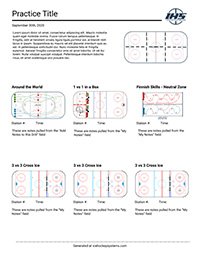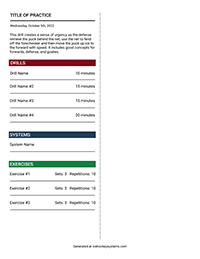Competitive Station Games With No Goalies
Competitive Station Games With No Goalies

Practice Notes
Please Note: The Practice of the Week is usually designed to be utilized across multiple age levels. With that being said, we highly encourage you to adjust the drills based on your team's age and skill levels. These drills and practices can be modified to become more basic or more advanced.
Practice Theme: The drills in this station based practice are designed to create competition & fun when no goalies are available. If you have goaltenders available, you can modify the games that are shown below, or you can view our list of 100+ small area games.
Practice Coaching Points:
Coaches: Keep score in every game listed below. The players competitive fire will start to come out if they know there is a goal, and you are keeping score. You can even divide all of the players on the ice in half and have a full Battle Practice (where you keep score of every game and award a winner at the end of practice).
Playing Habits: Coaches should reinforce good habits throughout practice, and players should be aware of them as they go through each station. 4 habits to consider reinforcing are:
- Have fun & work hard!
- Keep head up - scan the ice to be aware of threats, opportunities, and open space.
- Keep stick on the ice - keeping your stick on the ice will give your teammates a passing target when you are on offense, and help block passing lanes when you do not have the puck.
- Communicate with teammates - when playing, let them know if you are open or pressure is coming. If you are watching from the sidelines, support and cheer for your teammates!
Practice Layout
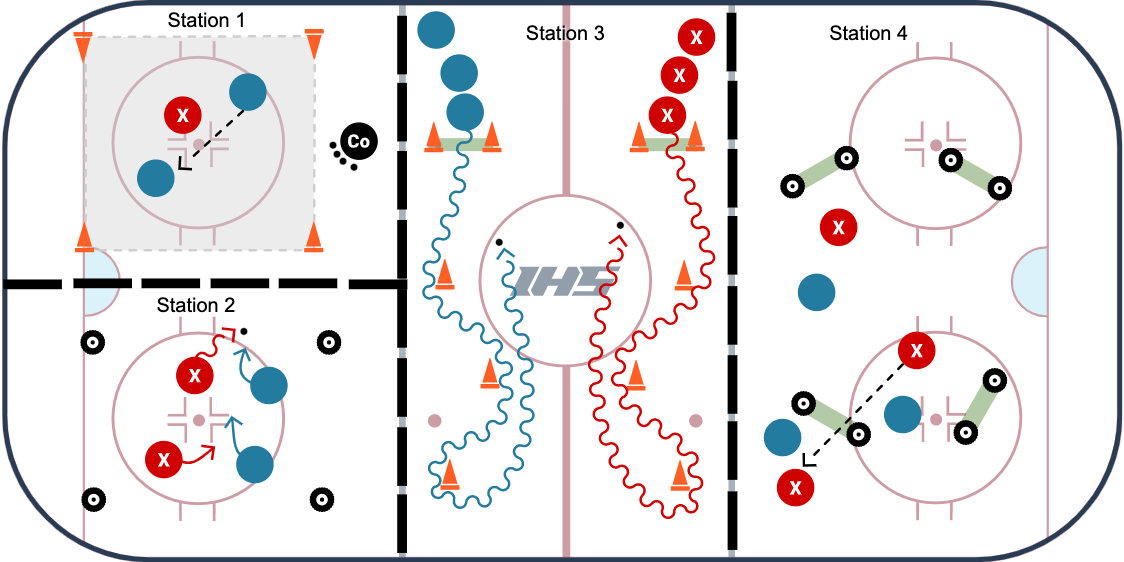
Tips To Increase Competitiveness & Work Ethic In Practice
Topher Scott gives coaches 3 tips to increase Competitiveness & Work Ethic in practice.
7 Pass 2 vs. 1 Small Area Game
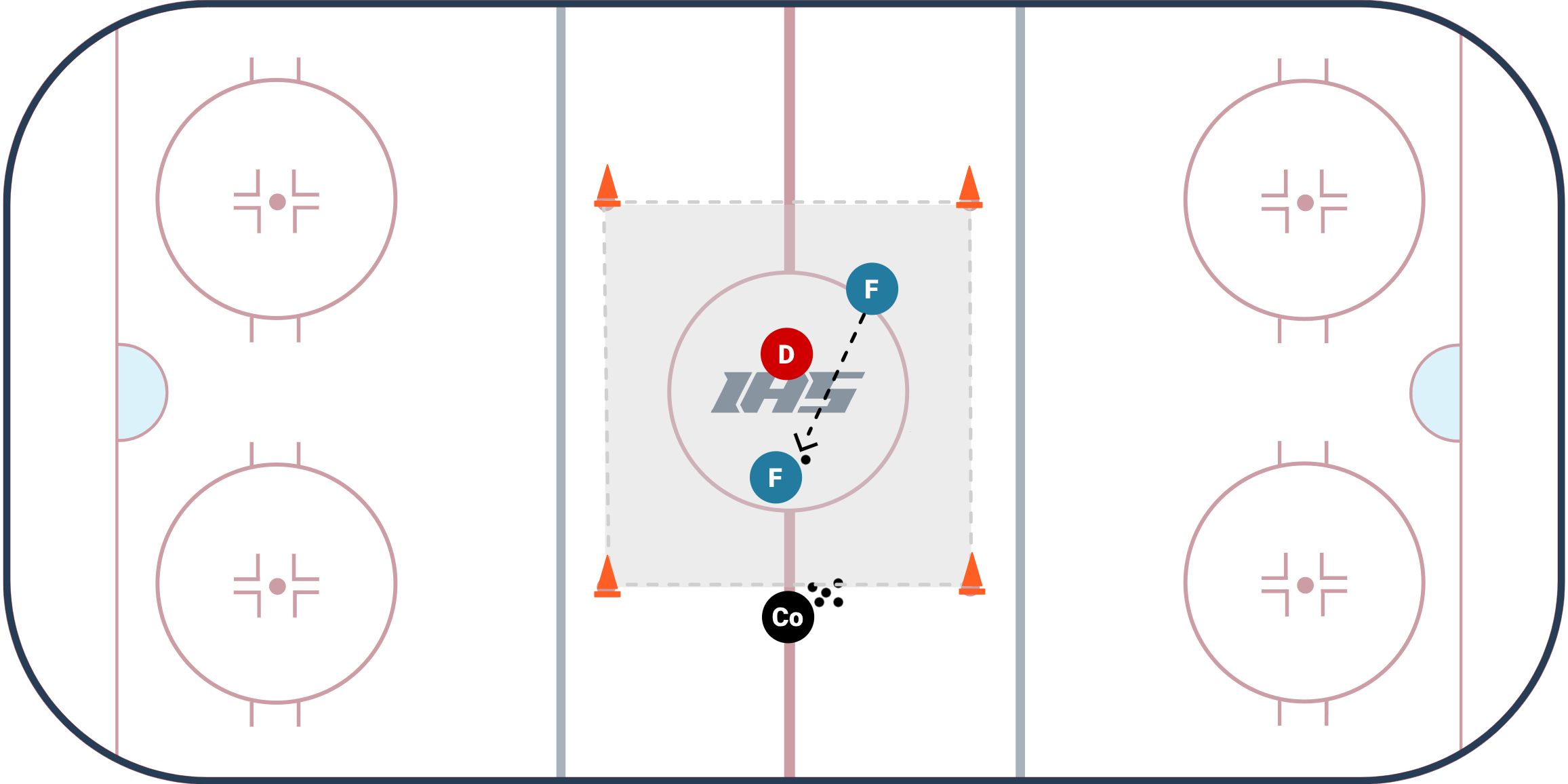
This small area game that focuses on passing and moving without the puck. It appears to be simple but go ahead and give it a try with some elite level players and you will see them struggle, it is not nearly as easy as it looks.
Setup
Place a cone on each of the neutral zone face-off dots to mark the boundary. Two offensive players and one defensive player will be inside the playing area with the coach just outside the box with pucks. On the whistle, the coach will play a puck to the offensive players who will move throughout the playing area making as many passes as they can. The defender will try to break up the play and intercept passes and if they get the puck they can just shoot it out of the box. It the puck goes outside the box the coach plays a new puck to the offensive players right away. As players make completed passes the coach will count out loud each time a successful pass is made.
Objective
The offensive players try to make 7 consecutive passes (or 5 consecutive passes for lower age groups).
Goalie Variation:
- If you have a net and a goaltender, let forwards attack the net after 7 passes have been made. Goalies can work on tracking the puck with shuffles, t-pushes, and slides.
Coaching Points
- The key is for players to pass and move. There will be a tendency for players to pass and watch but this cannot happen in a small area.
- Remind players without the puck they have to help their partner by giving them a good target, moving and always being ready for a pass.
- Defensive players should have active sticks, stop and start, and skate in straight lines.
Back to Back 1 vs 1 with Mini Nets
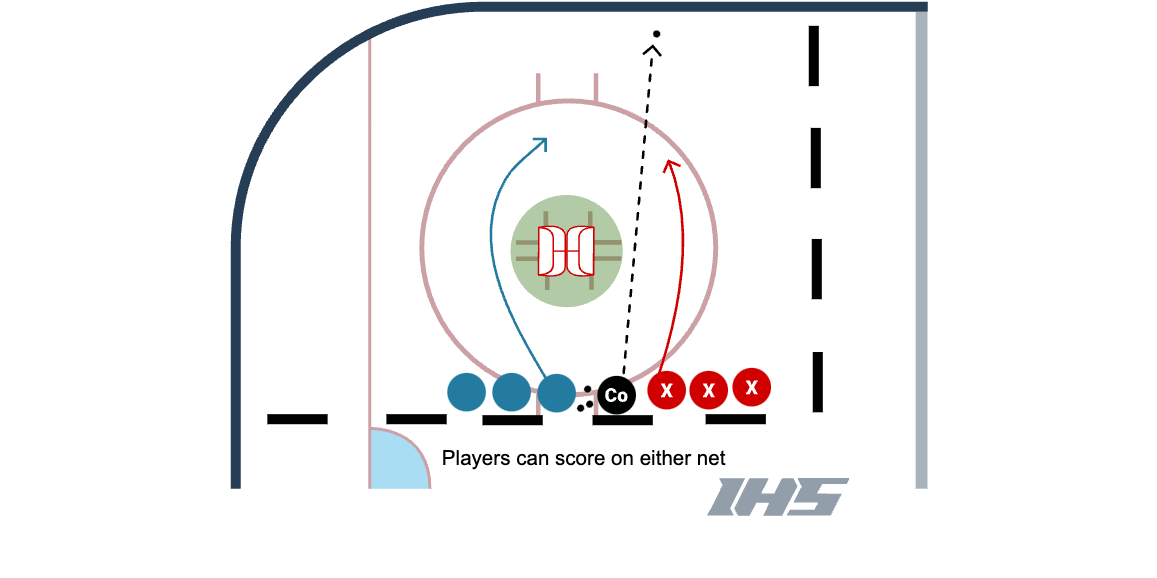
This is a really good battle drill where players work on puck protection in a tight space. This game was first posted on Twitter by Dave Breen (view video here).
Setup
- Create a small space using borders and the wall as shown in the diagram. Place two mini nets back to back in the center of the playing area. The coach has the pucks between the two lines of players.
How to Play
- The coach dumps a puck into the playing area and one player from each line competes for the puck. Players are allowed to score on either net. If a player scores the coach plays a puck into the playing area right away. Allow players to play for 30 - 40 seconds.
Variations
- Can use 2 mini nets, 2 large nets, or even just one tire!
- Only allow the players to score on a certain net.
- Make the game 1v1 or 2v2.
- Modify the playing area.
- Add goalies.
Coaches can use the Back to Back 1 v 1 with Mini Nets as a replacement to the 7 Pass 2 on 1 shown above.
Potential modifications:
- If you do not have 2 mini nets you can have one small goal in the middle (a cone, or tire) that players battle to score on
Corner Tires - Small Area Game
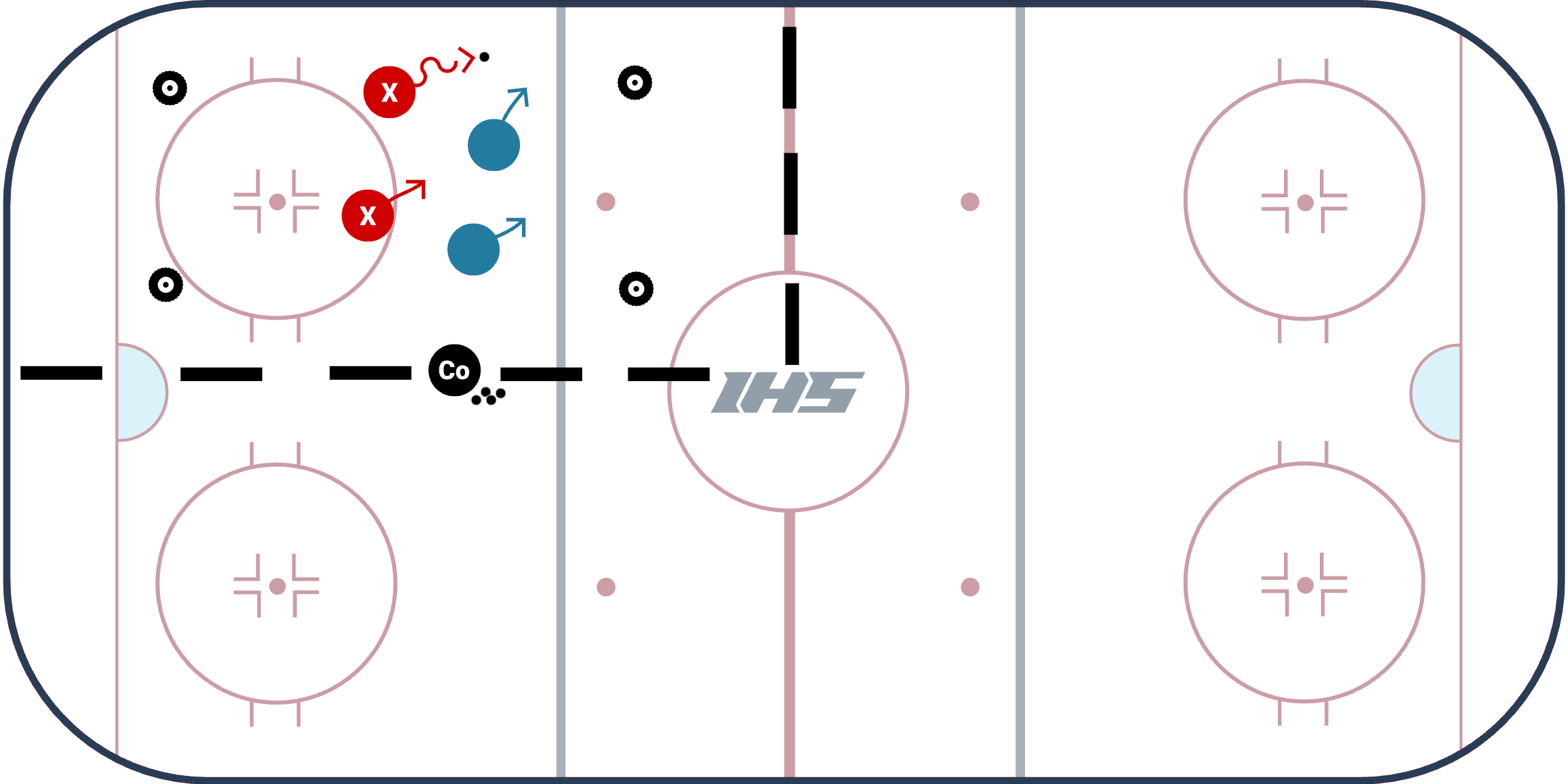
Corner Tires is a small area game where the players score by hitting the tire with a puck.
Set Up
Place four tires on a rectangle as shown in the diagram. Make sure there is enough room from the tires to the edge so that there is room to play on all sides of the tires. The coach has the pucks along the edge with the players split into two teams on each side.
How the game is played
The coach will dump a puck into play and two players will compete for the puck. The players will defend the tires on their side of the ice and try to score by hitting either tire on the opponent's side of the ice. After about 20-90 seconds the coach blows the whistle and dumps a new puck into play and two new players from each team play the new puck. Coach should keep the overall score so the teams are battling against each other.
Coaching Points:
- Encourage puck protection and keeping your head up
- Move to open space when you do not have the puck so you can be an outlet for your teammate
- Utalize verbal & non-verbal communication.
Variations:
- Can be played 1v1, 2v2, or 3v3.
- Can be setup in smaller or larger areas of the ice.
Credit: Diagram and animation produced using Hockey Coach Vision
Potential modifications:
- Can set up in different areas of the ice, or have smaller or larger playing dimensions
- Can set up one tire on each end if players are scoring too frequently
- Can require players to pass the puck to a coach before they are allowed to start playing offense (example - if a team is on defense and they get the puck from the offense, they need to pass to the coach and get a pass back before they can start attacking)
Neutral Zone Relay Race

A neutral zone relay race that has two teams battle it out against each other. Coaches should make sure teams are even as possible to increase competition and fun between the players.
Drill setup: Make teams as even as possible. On the whistle, players work to skate through the obstacle course (you can make the course anything you want), and then they give the puck to their next teammate in line. Whichever team finishes first, wins.
Potential modifications:
- Can modify the obstacle course to anything you want
- Can require players to work on particular skills as they go through the cones (here are 36 skills)
- Can set up puck races where both players race & battle over one puck (view example)
- View 20+ other race ideas
Gates of Buffalo 3 on 3 Game
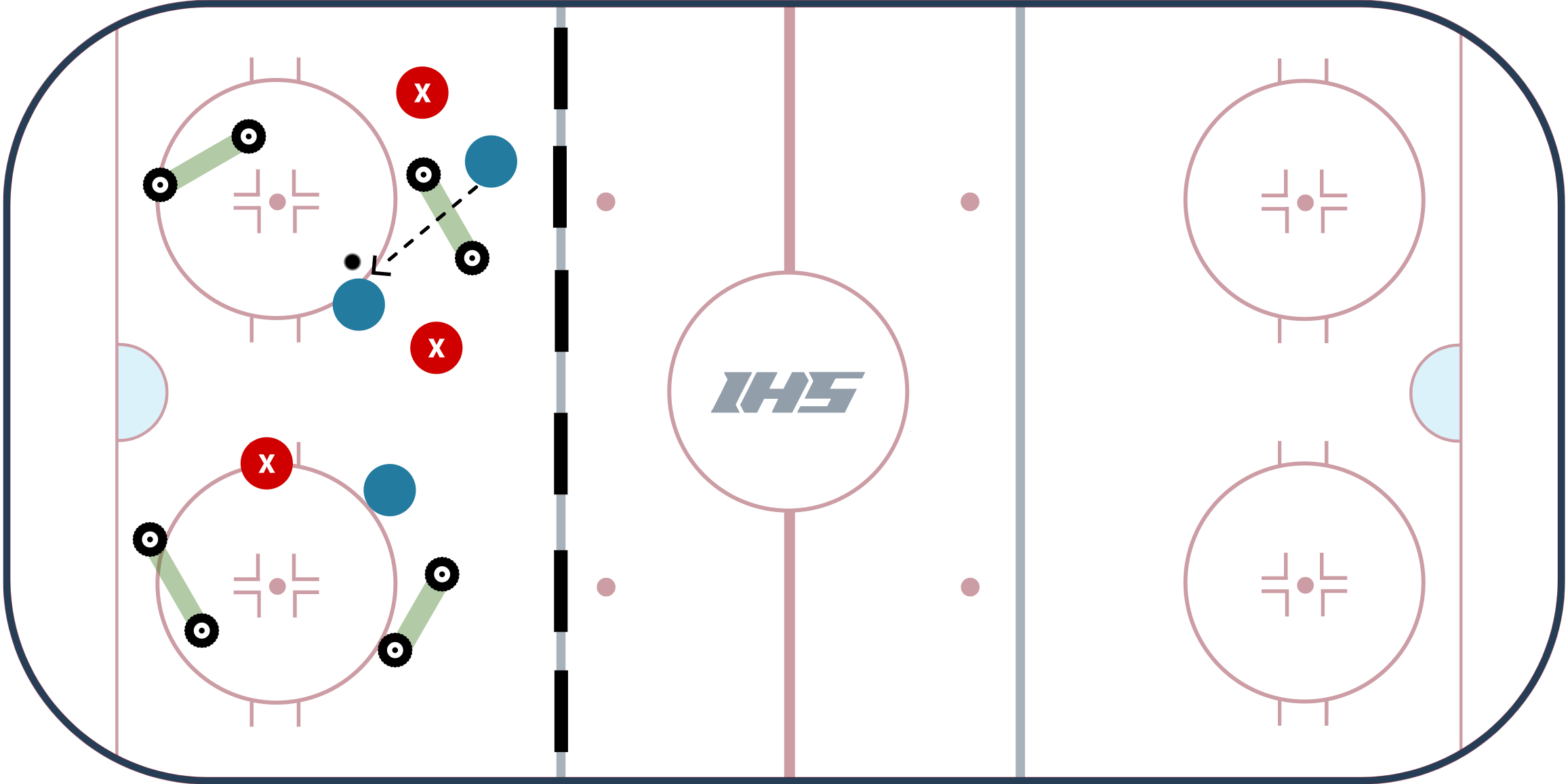
Gates of Buffalo 3 on 3 Small Area Hockey Game builds off of the Gates of Buffalo Passing Game by adding a 3 on 3 game element to it. The goal is to pass the puck through gates to score more goals than the other team. This game is great for practicing puck protection, moving to open space, communicating and passing.
This game framework will help players learn to play with their head up, communicate with teammates and move to open space. This game will look extremely messy at first, but players will get better with each repetition. Moving to open space, and moving the puck will eventually become second nature to the team. As a coach, If you commit to working on games like this instead of memorization drills for a portion of each practice, you will marvel at how your team begins to work together.
GAME OBJECTIVE
- Score goals by passing through the "Gates."
- Score more goals than the opposing team.
- You can not pass through the same gate twice in a row!
SETUP & ACTIVITY VARIABLES
- Players: great for 2 on 2, 3 on 3, 4 on 4 or 5 on 5 games.
- Time: You can rotate through groups of players in 30, 45 or 60-second shifts and count how many goals are scored.
- Space: can be set up to be within a zone, or half of a zone (station) or a smaller area. The smaller the space, the more challenging it will be for the players as they are forced to make quicker decisions.
- Group Competition: Count the number of successful goals made to naturally bring out the competition between teams.
- With a Goalie: You can require the players to make 2 (or more) passes through a gate before they can shoot on net. After they shoot on net, they need to make the required number of passes through the gates again. The goalie should work on tracking the puck when the team is not actively shooting on net.
- Gates: You can add 3 or more gates. They can be made of tires, cones, pucks and other materials. Change up the sizes of the gates for an extra challenge. The smaller the gate, the more accurate the pass must be!
Setup Suggestions for Elite Players
- Make the gates much smaller.
- You can add a hockey stick at the bottom of each gate so players must "sauce" through a gate and over the stick for the point.
- Add various obstacles on the ice such as sticks that players must be aware of and pass around or sauce over.
- If you have a goalie, require 2 or more passes through the gates before players are allowed to take a shot on net. Even though the goalie will not get as many shots, they can work on tracking the puck!
COACHING POINTS
- Encourage players to always move to open space on the ice. Do not allow them to stand still and pass the puck back and forth.
- Encourage players to find "passing lanes" for good passes.
- Encourage verbal communication (calling teammate by name, saying you are open, etc).
- Encourage non-verbal communication (good eye contact, showing a passing target, tapping a stick, etc).
- Allow players to make mistakes. It will take time to get comfortable with these activities. But as time goes on you will see them picking their head up to make a decision, which is the goal of this small area game.
Why do we call this small area game "Gates of Buffalo 3 on 3 Game?" The game has been called "gates" in the world of soccer and we decided to add Buffalo to it for two fun reasons: First, IHS has strong ties to Buffalo, NY. Secondly, the imagery of a Buffalo can help drive home to your youth players why you are practicing this game. If you do not pick your head up and use your teammates while playing the game of hockey, you run the risk of getting trampled by the other team. This can feel like getting run over by a Buffalo (physically or on the scoreboard). This game helps prevent both of those situations by forcing players to keep their head up while communicating and working with teammates to score goals.
Potential modifications:
- Can be setup to be 2 v 2 or 3 v 3.
- Can add or remove gates
- The smaller the gate, the harder it is to score!
- Can make a 2 point gate that is really small.
Four Corners Possession Game
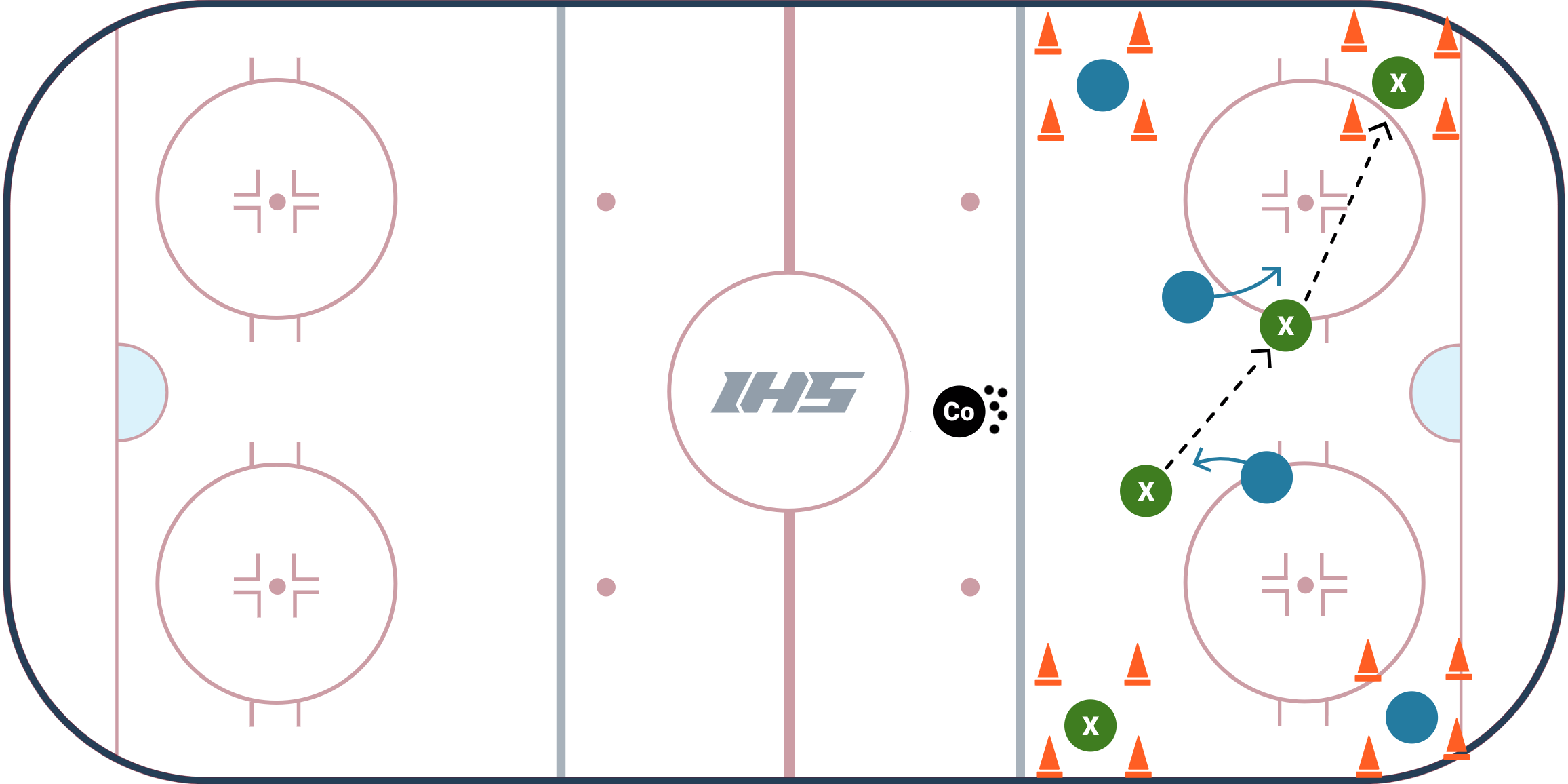
This is a possession game with 4 players on each team that can be set up in any of the zones. The goals is to pass to your teammates in the "cones" to get points.
Setup:
- Mark out 4 squares as shown in the diagram. Each square will have a player from one of the teams and the player is not allowed to leave that square. The two other players from each team will play 2 vs 2.
- Every time they make a pass to their teammate inside their square they will get a point. The pass must be received cleanly inside the square. A team can maintain possession for as long as they want and collect as many points as they want until the other team intercepts or takes the puck away.
- A coach should be stationed just outside the zone with pucks. Anytime a puck goes outside the zone the puck will play a new puck into space so players can battle for a loose puck.
- After 30-60 seconds the coach blows a whistle and the players that were in the game can rotate out of the playing area, or can switch with the players who are in the cones.
Coaching Points:
- Head Up! Encourage players to play with their head up so they can look out for their teammate and other scoring options.
- Protect the Puck: Protect the puck before you have time & space to make a good pass.
- Communicate: Practice verbal and non-verbal communication with your teammates.
Variations:
- This can be played in different areas of the ice.
- Coaches can add obstacles into the ice to force the players to pass around & over.
- Can be set up to be 1v1, 2v2, or 3v3 game.
- Add a goalie! After a certain # of passes, or a point, a team can shoot on net.
Coaches can end practice with the Four Corners Possession Game or they can use it instead of Gates of Buffalo 3 v 3.
Potential modifications:
- Can be modified to be 3 v 3
- Can make the support players "cone area" smaller or larger
- If the front cones are getting in the way, coaches can remove them and only have cones against the boards to show where the support areas should be.
- Can move the location of the support players.
- After a rep, players in the game rotate out to be support players.
Additional Resources
Related Drills & Games
- 100+ small area hockey games
- 65+ battle drills
- 10 hockey games to play with no goalies
- 7 ways to play games with one goalie
Related resources:
- 8 important hockey habits every player should know from Topher Scott
- Battle practice day from Kendall Coyne
Members only resources:
- Athlete development & the slight edge from Alyssa Gagliardi
- Create your own practice plan that looks like this. Watch video.
